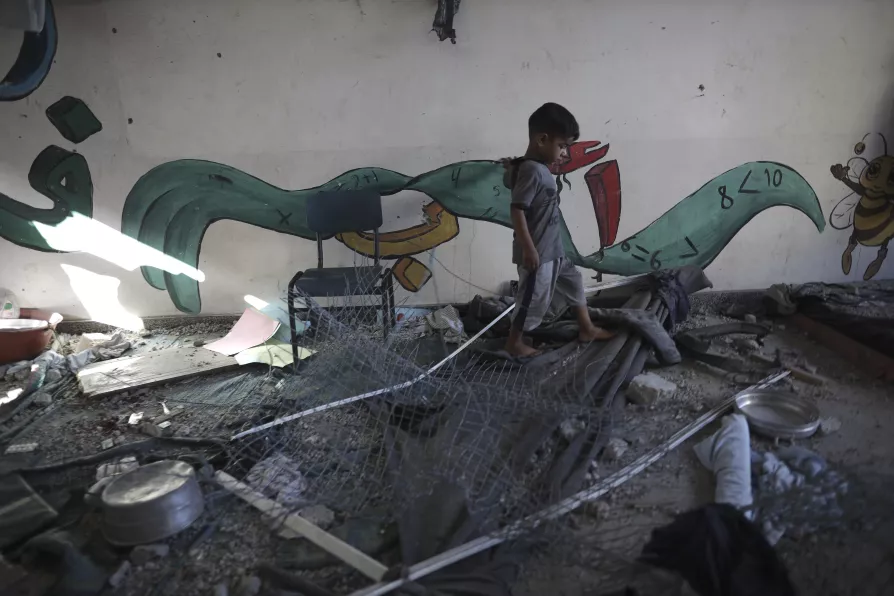
 A Palestinian child navigates through heavy damage to a UNRWA school, June 21, 2024
A Palestinian child navigates through heavy damage to a UNRWA school, June 21, 2024
THE story should not be real. It was the morning of January 29, 2004. The Israeli military had already bombed substantial parts of the affluent Tel al-Hawa neighbourhood in Gaza City, including — in October 2023 — the totality of the Gaza City campus of the Islamic University of Gaza.
Following a warning from the Israeli military, seven members of a family got into a Kia Picanto to flee southward. But the Israeli bombing had levelled a nearby high-rise, so the car had to go north before it could go south.
Not far down the road, the car came under fire from Israeli military vehicles, including Merkava tanks. According to a remarkable investigation by Britain-based research agency Forensic Architecture, 355 bullets were fired into the car.
One of those in the car, a six-year-old child named Hind Rajab, called emergency workers. “They are dead,” she says of her family members. “The tank is next to me. It’s almost night. I am scared. Come get me, please.” The Palestine Red Crescent Society (PRCS) sent an ambulance to rescue her.
Two weeks later, on February 10, Hind Rajab’s dead body was found near the bodies of her family, along with those of the paramedics (Ahmed al-Madhoun and Yusuf al-Zeino) sent to save her.
“The tank is next to me,” says the young girl on a tape saved by the PRCS, but both the US State Department and the Israeli military say that no tanks operated in the area at that time. It is the word of a murdered child against the world’s most dangerous and disingenuous governments.
The murder of Hind Rajab and her family shocked the world (Hind Rajab’s father was killed in a separate attack in late June). When the students at Columbia University occupied their administration building, they named it Hind Rajab Hall; the singer Macklemore released a song in May called “Hind’s Hall.”
Everyday violence
June 14: One child was killed by Israeli air strikes in Zeitoun (Gaza City).
June 22: Two children were killed by Israeli air strikes in Shujaiya (Gaza City).
June 25: Two children were killed by Israeli fire on al-Wahda Street, near Al-Shifa Hospital (Gaza City).
June 25: Three children were killed by Israeli air strikes in the Maghazi refugee camp.
Each of these stories is about precious children, most of whom have not even reached the age of 10. Some of these children lived through the barbarous Israeli bombardment of 2014 when over 3,000 children were killed.
Sitting in the homes of families in Gaza City and Khan Younis in the aftermath of that war, I heard story after story about children killed and children maimed (Maha, paralysed; Ahmed, blinded — my notebook a mess of loss and sorrow).
As the bombs continued to fall in 2014, Pernille Ironside, then-chief of the Gaza office of the UN Children’s Fund (Unicef) said that 373,000 children needed “immediate psycho-social first aid.” There were simply not enough counsellors to help the children, most of whom are now hardened because of the ugliness of occupation and war.
The violence that they experience has become a daily affair. But this kind of violence can never be mundane. “I am scared,” said Hind Rajab. I remember meeting a little boy who was playing with a football on the streets of al-Mughraqa.
His father, who was showing me around, told me that the boy was not able to sleep, but would stay awake at night and cry. That was in 2014. That boy must now be in his early twenties. He might not be alive.
One or two legs
An Al Jazeera interactive website has the names of the children killed since October 2023, one killed every 15 minutes; as I scrolled down the names, I felt ill, and then found this at the very end: “These are the names of only half of the children killed.”
In early May, Unicef director Catherine Russell said, “Nearly all of Gaza’s children have been exposed to the traumatic experiences of war, the consequences of which will last a lifetime.”
In her statement, where she reported that 14,000 children have been killed, she said that “an estimated 17,000 children are unaccompanied or separated.” These numbers are estimates and are likely to be undercounts.
A new report from Save the Children suggests that over 20,000 children are missing in Gaza. They are either under the rubble, detained by the Israeli military, or buried in mass graves.
During a detailed briefing on June 25, the Commissioner-General of the UN Palestine Agency (UNRWA) Philippe Lazzarini said something staggering: “And you take into consideration that basically, we have every 10 days children losing one leg or two legs on average. This gives you an idea of the scope of the type of childhood a child can have in Gaza.”
The story should not be real. It was the morning of December 19, 2023. Israeli tanks rumbled through the neighbourhood of Rimal in Gaza City. Seventeen-year-old Ahed Bseiso was on the top floor of a six-floor building trying to call her father in Belgium to tell him that she was still alive.
She heard a loud noise, fell, and called out for her sister Mona and her mother. Her family rushed up, carried her down, and laid her on the kitchen table where her mother had been making bread.
Ahed’s uncle Hani Bseiso, an orthopaedic doctor, looked at her leg and realised that he would have to either amputate it or she would die. He grabbed whatever supplies he could find and conducted the amputation without anaesthesia.
Ahed recited verses from the Quran to calm herself. Hani wept as he did the operation, which the family filmed and later posed on YouTube, which was reposted in many places.
These are the stories of Gaza.
Vijay Prashad is an Indian historian, editor and journalist. He is a writing fellow and chief correspondent at Globetrotter. He is an editor of LeftWord Books and the director of Tricontinental: Institute for Social Research. He has written more than 20 books, including The Darker Nations and The Poorer Nations. His latest books are Struggle Makes Us Human: Learning from Movements for Socialism and (with Noam Chomsky) The Withdrawal: Iraq, Libya, Afghanistan, and the Fragility of US Power. This article appeared on Peoples Dispatch.

MARIA DUARTE recommends the powerful study of an underfunded reform school and the staff who struggle to do good













